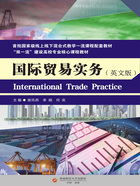
1.2 Overview of International Trade Methods
1.2.1 Evolution of Trade Methods
Trade method is a summary of the transaction process. It answers the specific question of how we should carry out international trade. Based on the development course of international trade, we can make such a brief summary of the evolution of trade methods:
For ancient international trade, the trade method mainly took the simple way of barter, usually made by residents of neighboring countries to exchange goods for goods.
Market trade appeared around the middle ages when some countries set up international markets within their borders, allowing traders from other countries to sell their own products and buy local products there.
Modern international trade is mainly based on sales contract, i.e., the buyer and seller complete the transaction by signing and performing the sales contract. In addition, other flexible and diversified trade methods emerge, such as bidding, agency, processing trade and so on.
Accordingly, we can divide the trade methods of modern international trade into two categories: the first category includes one method — the contract-centered trade method, and the second category generally refers to the other trade methods used in practice.
1.2.2 Contract-centered Trade Method
Contract-centered trade method, also known as contracting, refers to the trade method that the buyer and seller complete the import and export trade by signing and performing an international trade contract. Since international trade contract are prepared by the seller in most cases, it is often referred to as sales contract (SC) .
A sales contract is a contract under which a seller transfers his ownership over the subject matter to a buyer who pays the price in return . And international sales contract is such a contract signed between the seller and the buyer whose places of business are in different countries.
. And international sales contract is such a contract signed between the seller and the buyer whose places of business are in different countries.
A sales contract usually includes the following items:
① Names and addresses of the buyer and seller.
② Name and quality of the goods.
③ Quantity.
④ Packing.
⑤ Unit price and total amount.
⑥ Term of delivery.
⑦ Transportation.
⑧ Insurance.
⑨ Payment.
⑩ Liability for breach of contract.
⑪ Dispute resolution clause.
By signing sales contract, the buyer and the seller can agree on the contents of the transaction in terms of the terms of the contract, and then the buyer and the seller can accomplish the trade by performing their respective responsibilities according to the contract. For example, the seller is responsible for delivery of goods at the time specified in the contract and the buyer is responsible for payment at the time specified in the contract, etc.
1.2.3 Other Trade Methods
Other trade methods generally refer to methods other than the contract-centered trade method, including underwriting, agency, consignment, exhibition, commodity futures, tendering, auction, counter trade, processing trade, cross-border e-commerce, etc. Each trade method has its own characteristics and can meet the special needs of international trade.
1.2.4 Innovative Development of Trade Methods in China
Although a variety of mature trade methods have been formed in the evolution of international trade, it is necessary to continuously improve the existing ones and supplement new ones to promote the sustainable development of international trade. In this regard, China is taking positive actions. In July, 2021, the State Council of the People’s Republic of China issued the Opinions on Accelerating the Development of New Forms and Models of Foreign Trade, putting forward the goal that the development level of China’s new forms and models of foreign trade will rank in the forefront of innovation-driven countries by 2035.
According to this document, the new forms and models of foreign trade that China currently focuses on include the following types:
① Cross-border e-commerce.
② Overseas warehouse.
③ Market procurement trade.
④ Comprehensive service enterprises for foreign trade.
⑤ Bonded maintenance service.
⑥ Offshore trade.
Such new forms and models reflect China’s exploration and innovation in the field of foreign trade development in recent years. They are the supplement, optimization and upgrading of traditional trade method of international trade.